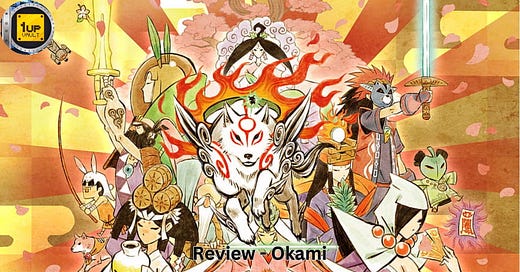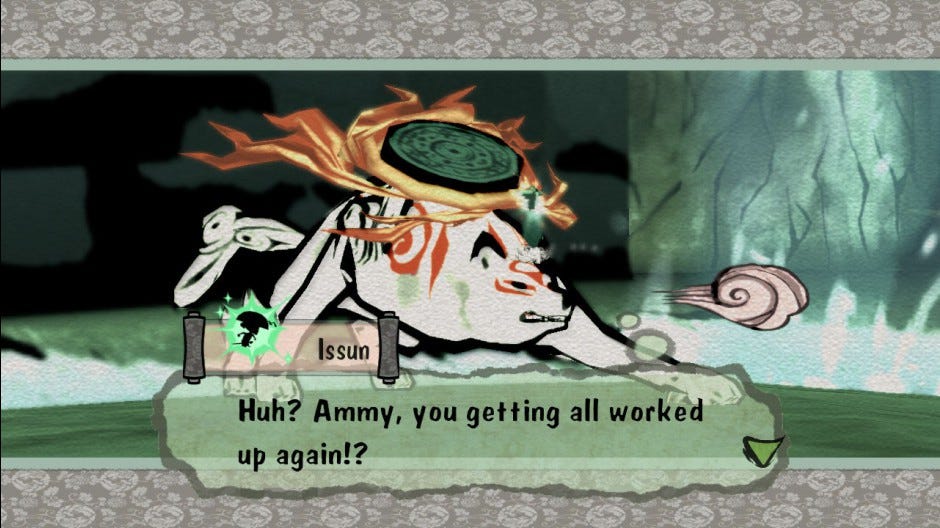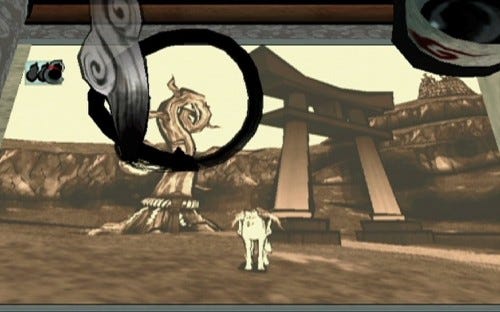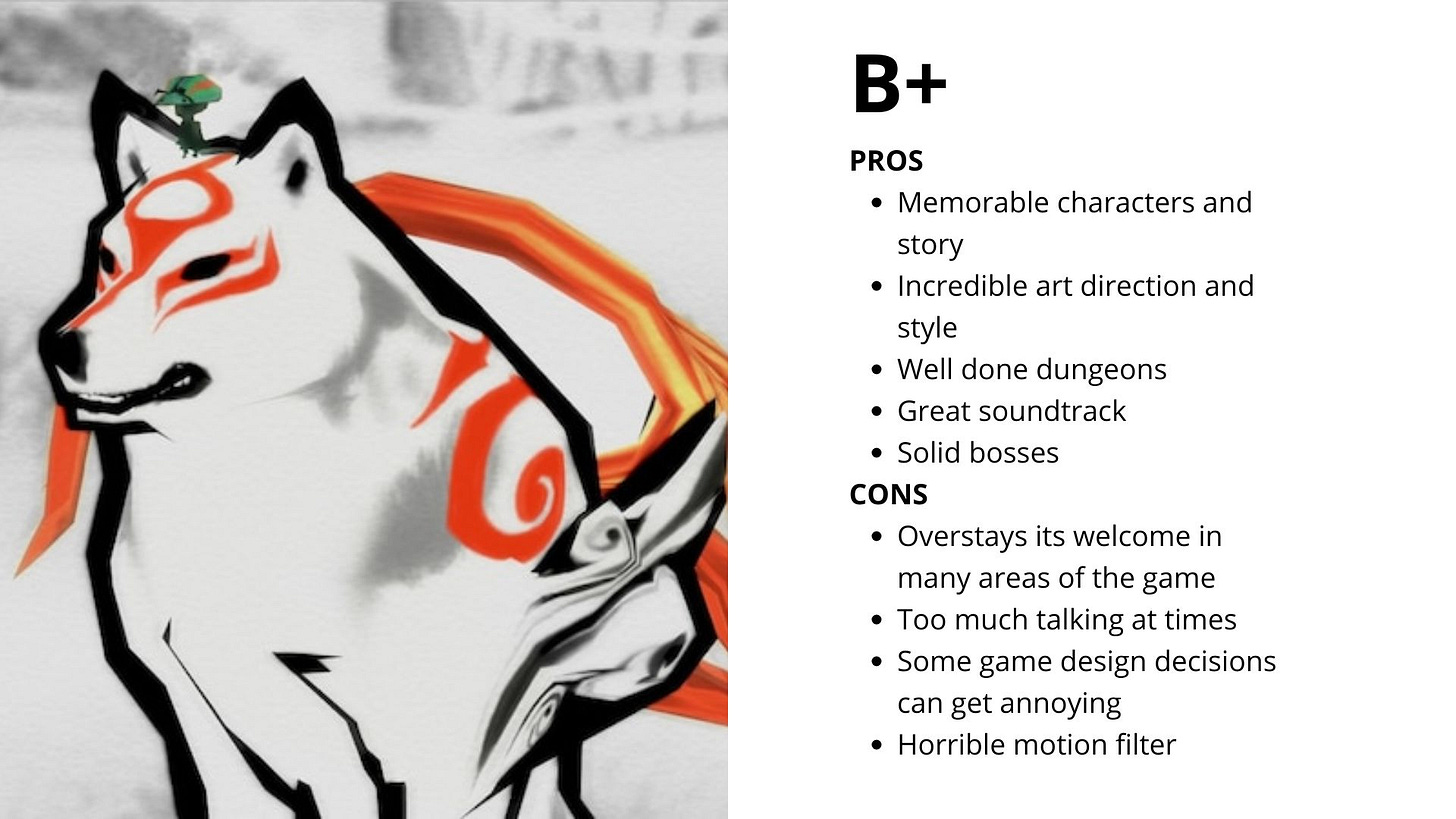Okami HD
Capcom, Clover Studio, HexaDrive (HD Version)
Played HD Version on Xbox Series X
The Plot - One hundred years after taking down the evil Orochi, the goddess Amaterasu is reincarnated into a white wolf and teams up with the artist Issun, a bug-sized small creature with a big mouth, to save Nippon (Japan) after Orochi’s spirit is let out. From there, you’ll embark on a journey filled with side characters and multiple character arcs while healing the land from darkness.
Characters and Story
Okami’s characters and story have a lot going for them. The set-up of the story, traveling across the land and meeting multiple characters with their own story arcs, had the feeling of the pacing you see in many Zelda games—and that’s one thing you always hear about—perfect for fans of The Legend of Zelda series. The chase to stop Orochi and heal the land is based on Japanese folklore, and as someone who’s big on history and different cultural teachings, I was hooked from the start.
The game’s side characters are as memorable as the story is. You’ll meet multiple characters, some with different arcs, yet they connect the whole story even though some are there more for side quest purposes. Issun, your companion who does the talking, quickly became one of my favorite characters. He’s a big mouth and drops several comedic lines while still having his story come to a satisfying conclusion. He tends to flirt and make politically incorrect jokes around the many women you meet, but I never felt it was offensive or in poor taste - plus, remember, this is a 2006 game. There’s also Waka (a mysterious person who seems to taunt yet help our heroes), Susano (a self-proclaimed hero and descendant of legendary hero Nagi), Queen Himiko (who is guarding an important item to save her land), and many others.
The game’s story, however, does do something that proved to be a weakness for me. It splits the game into three acts. Think of it like an anime with different arcs and a different story. The main story is told throughout the game, but the split gives us what ended up being three different villains. This surprised me, making it seem like I was hitting the ending several times, only for it to continue. As a result, it made it feel like there were several endings, and I felt like the game was overstaying its welcome. I wasn’t hating the story; I was loving it, but the end of each arc made it feel like it was teasing me and made me want to hurry up to beat it. Again, I loved this story but really wish they didn’t have three arcs.
Gameplay
The leading gameplay hook for Okami is in the Celestial Brush you have access to. It can solve puzzles, manipulate the wind, melt ice blocks with fire, slow down time, and even attack. This was a cool and interesting mechanic that I really liked. The problem, however, is that I felt it either didn’t work at times or would run out of ink too fast. Yes, you can refill your ink with items and even temporarily make it infinite, but I didn’t think that was a good design choice. Just let me have the brush and not put an unnecessary ink limit on it.
The combat is pretty standard, although you can make it a little more exciting if you start hoarding exorcism slips, which can damage or boost your stats. You’ll attack either dashing at your enemies or using your ink as bullets. While it was basic for me, it was tolerable. The real good part of fighting is the bosses. Each boss is well done and has gimmicks similar to those of the Zelda bosses. While there was one specific boss you fought three times in the game, the rest are varied and have memorable battles. The dungeons also have a Zelda-like feeling to them and are well-designed. So much of this game reminded me of The Legend of Zelda, and anyone who knows me knows that’s high praise.
However, that brings me to the most annoying part of the gameplay: constant interruptions and talking. Now, I’m not kidding when I say the intro cut scene to this game is nearly twenty minutes. If I were playing a Kojima game, that would check out, but this is not the case. Yes, they had to explain a lot of vital lore to start the story, but I wish they found a way to tell you quickly or split it up better initially. Throughout the game, characters have long dialogues, all text-based. That wouldn’t bother me if it weren’t for how long it takes for one text scroll to pass. Add this to the feeling the story was taking too long, and you start to see why I began to feel like it was overstaying its welcome. Again, I probably would’ve tolerated it better if the text wasn’t given to me so slowly.
Graphics, Presentation, and Music
The main thing you’ll hear about Okami is the art direction and music. The art style is based on sumi-e and ukio-e Japanese watercolor art. Some beautiful art is also shown when you meet certain characters and enemies. This is where the game’s cult status comes from, and for good reason. The art direction mixed with a damn good soundtrack and sound mixing adds to the overall experience. It is one of those games that is a games as art type of situation as you move along the world and learn to appreciate the presentation of the game as it respects traditional Japanese folklore.
Unfortunately, it comes with a very annoying motion filter that you can only turn to low at best but can’t fully turn off. It took about halfway through the game for me to get used to the filter, and that was probably helped by my focus on the actual playing part of the game. I will never know why HexaDrive didn’t get rid of this in the HD port. I hope this doesn’t come back or can be turned off in the upcoming sequel.
Final Verdict
There’s a chance my score would be a bit higher if I had played this in 2006, but alas, I can only score this based on my time playing it - 2025. I liked this game, and I see why it has the cult following and status it does. It has excellent characters, a great story, solid bosses, and one of the best presentations in a video game. This is one of those gaming experiences you’ll remember and smile as the game reaches its conclusion. However, it’s a game that shows its age in mechanic decisions, too much dialogue at times, a story that could’ve been shorter, and an annoying motion filter. Even though it has a lot of annoyances, it doesn’t mean I hated my experience. I liked my time with Okami and can’t wait to see what they have cooking for the sequel. They have a masterpiece if they can replicate what they did here and fix the weaknesses. Until then, I’m happy to have played this and taken it off my gaming bucket list.
Be Nice to All!









Excellent review of a memorable game. I played the original version of this game back in the day and it left a big impression that I still remember tidbits of the game and animation over 15 years after I played it. Don’t get me started on the soundtrack; “Reset” remains one of the best video game tracks I have heard.
I do agree that it does go on with too much talking at times and I did feel that it was 5-10 hours too long by the time I finished it. I recall impatiently trying to get through the final act as quick as possible.
I started the game yesterday but after 23 minutes of set up chat I was too tired to even try playing it. It’s a shame you say it continues to be so text heavy, but I’ll have to give it a few hours of game play to see what I think.
It’s crazy I didn’t realise the game is nearly 20 years old! I wanted to play it before the sequel and enjoy it but I’ll see how I feel. Like you say if I’d started 20 years ago as it was released I would probably be halfway through the game already 🤣😅